While you might think transforming your living room requires a complete renovation, adding strategic greenery can create an instant impact. You’ll find that carefully selected houseplants can define spaces, soften harsh corners, and improve air quality without major construction or expense. Each of the following plants serves a distinct purpose: some reach dramatic heights of 6-10 feet, while others cascade elegantly from shelves or nestle perfectly into tight corners—and they’re all proven performers in indoor environments.
Contents
- 1 Fiddle Leaf Fig: The Dramatic Focal Point
- 2 Trailing Pothos for Bookshelf Magic
- 3 Snake Plants: Low-Maintenance Corner Companions
- 4 Bird of Paradise for Tropical Elegance
- 5 ZZ Plants in Modern Minimalist Spaces
- 6 Hanging Spider Plants for Vertical Interest
- 7 Peace Lily: The Air-Purifying Beauty
- 8 Statement Monstera for Natural Drama
- 9 Rubber Plants for Rich Color Contrast
- 10 Succulents for Window Ledge Charm
Fiddle Leaf Fig: The Dramatic Focal Point
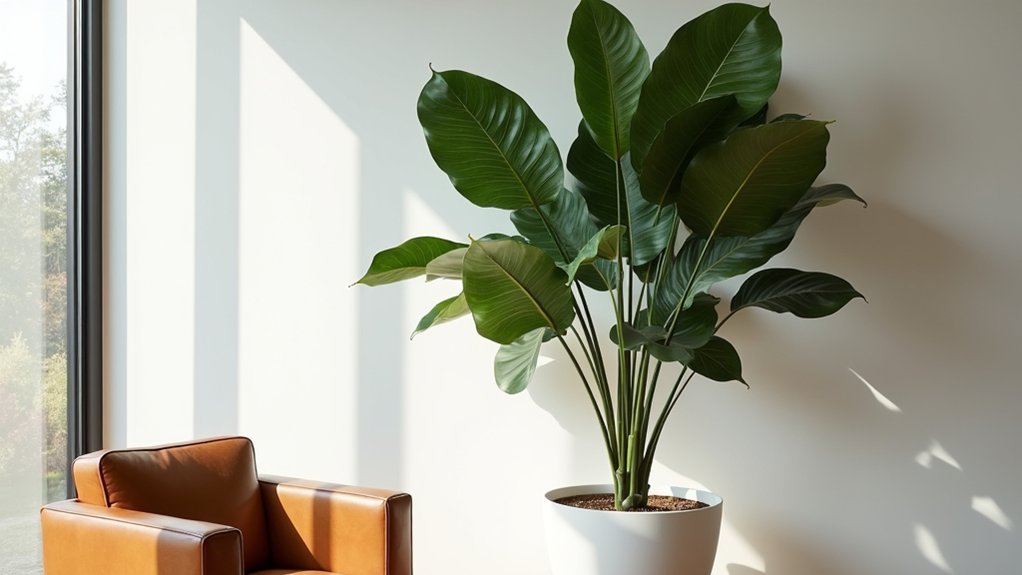
The Fiddle Leaf Fig (Ficus lyrata) commands attention with its impressive height and large, violin-shaped leaves that can grow up to 12 inches long. This striking indoor tree typically reaches 6-10 feet tall when grown indoors, featuring thick, glossy leaves arranged on upright branches.
Its architectural silhouette and bold foliage make it a popular statement piece in modern and contemporary living spaces.
- Light: Bright, indirect sunlight; morning sun is ideal; avoid harsh afternoon rays
- Water: Allow top 2 inches of soil to dry between waterings; reduce frequency in winter
- Soil: Well-draining, rich potting mix with good aeration
- Humidity: 40-60% humidity levels; benefits from regular misting
- Temperature: 60-75°F (15-24°C); avoid cold drafts and sudden temperature changes
- Fertilizer: Feed monthly during growing season with balanced liquid fertilizer
Regular maintenance for a Fiddle Leaf Fig involves rotating the plant quarterly to ensure even growth, wiping leaves with a damp cloth to remove dust, and pruning leggy branches to maintain shape.
Watch for signs of stress like leaf dropping or brown spots, which often indicate environmental issues. Supporting larger specimens with a stake helps maintain an upright position, while periodic repotting every 2-3 years in spring provides fresh nutrients and room for growth.
Trailing Pothos for Bookshelf Magic
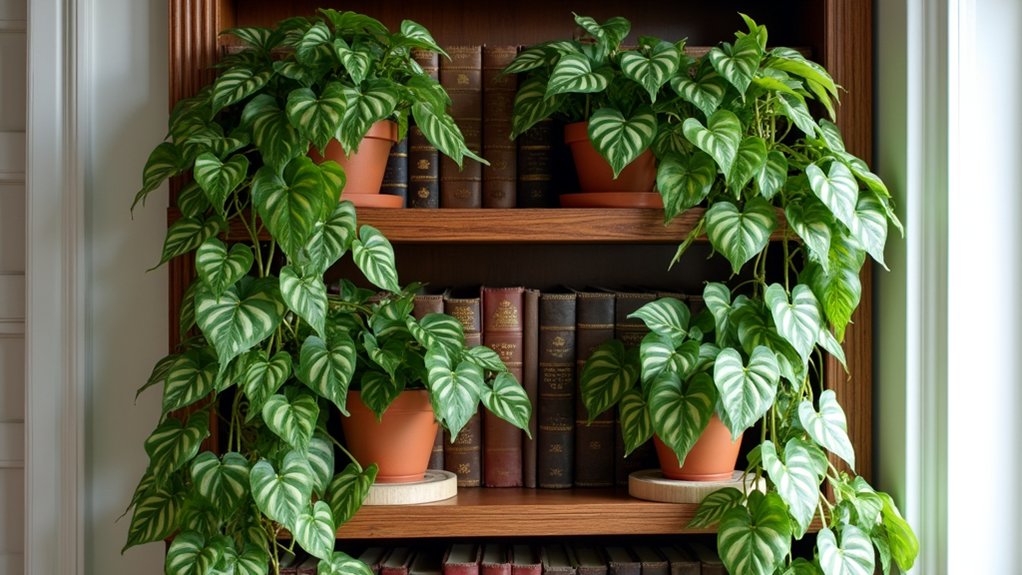
Trailing Pothos transforms ordinary bookshelves into lush, cascading displays with its heart-shaped leaves and elegant vines that can grow several feet long.
This versatile houseplant comes in various varieties, including golden, marble queen, and neon, offering different patterns and colors to complement any living room décor. As the vines gracefully drape over shelves and trail downward, they create a natural, jungle-like ambiance that softens hard edges and adds dynamic visual interest to reading nooks.
Growing Conditions:
- Light: Bright, indirect light; tolerates low light but may lose variegation
- Water: Allow top 1-2 inches of soil to dry between waterings
- Soil: Well-draining potting mix rich in organic matter
- Temperature: 60-80°F (15-27°C)
- Humidity: Average room humidity; tolerates dry air
- Container: Pot with drainage holes
Regular pruning keeps pothos looking its best while encouraging fuller growth and preventing the vines from becoming too leggy.
Remove yellowing or damaged leaves promptly, and wipe the leaves monthly with a damp cloth to remove dust and maintain their glossy appearance.
Consider rotating the plant periodically to ensure even growth, and use support structures like small hooks or clear command strips to guide the vines along desired paths on your bookshelf.
Snake Plants: Low-Maintenance Corner Companions
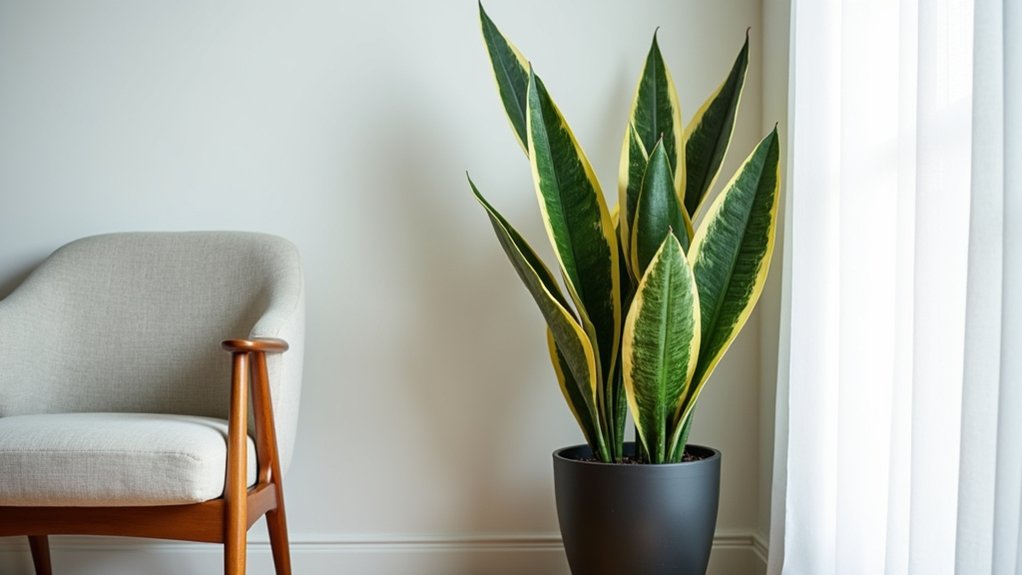
Snake Plants (Sansevieria) are striking architectural plants characterized by their tall, rigid, sword-like leaves that grow vertically from a basal rosette. These hardy succulents range from deep green to variegated patterns with yellow edges, and their distinctive upright growth pattern makes them perfect for adding height and visual interest to room corners without taking up much floor space.
- Light: Tolerates low light but thrives in bright indirect light; can handle some direct sun
- Water: Allow soil to dry completely between waterings; water less in winter
- Soil: Well-draining potting mix; preferably succulent or cactus mix
- Temperature: Comfortable in normal room temperatures (60-85°F)
- Humidity: Adaptable to any humidity level
- Container: Pot with drainage holes; slightly root-bound conditions acceptable
Regular dusting of leaves with a damp cloth maintains the plant’s glossy appearance and helps it photosynthesize effectively. Remove any yellowed or damaged leaves at the base, and watch for signs of overwatering, which is the main threat to these plants’ health.
While propagation isn’t necessary for maintenance, older plants can be divided when they become crowded, typically every 3-4 years, to create new plants or maintain their size.
Bird of Paradise for Tropical Elegance
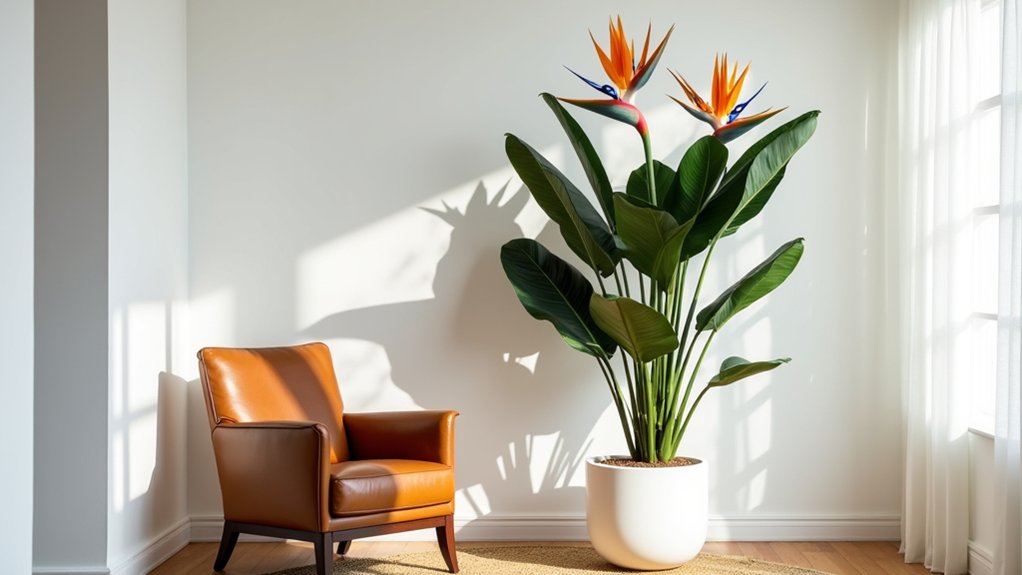
The Bird of Paradise (Strelitzia reginae) brings dramatic tropical flair to living rooms with its large, paddle-shaped leaves and distinctive orange and blue crane-like flowers that rise above the foliage. This statuesque plant can grow up to 6 feet tall indoors, creating an instant focal point with its upright, architectural form and glossy, banana-like leaves that fan out in a symmetrical pattern.
- Light: Bright, indirect sunlight; can tolerate some direct morning sun
- Water: Keep soil consistently moist but not waterlogged; water when top 2 inches of soil feel dry
- Humidity: Minimum 50%; benefits from regular misting
- Temperature: 65-80°F (18-27°C)
- Soil: Well-draining, rich potting mix
- Fertilizer: Feed monthly during growing season with balanced fertilizer
- Container: Large pot with drainage holes to accommodate extensive root system
Regular grooming is essential for maintaining a Bird of Paradise’s striking appearance. Remove yellowed or damaged leaves at the base using clean, sharp scissors, and dust the broad leaves weekly to maintain their glossy appearance and ensure efficient photosynthesis.
Rotate the plant quarterly to promote even growth, and inspect regularly for spider mites, which are attracted to the plant’s large leaves. During winter, reduce watering frequency but maintain humidity levels to prevent leaf browning.
ZZ Plants in Modern Minimalist Spaces
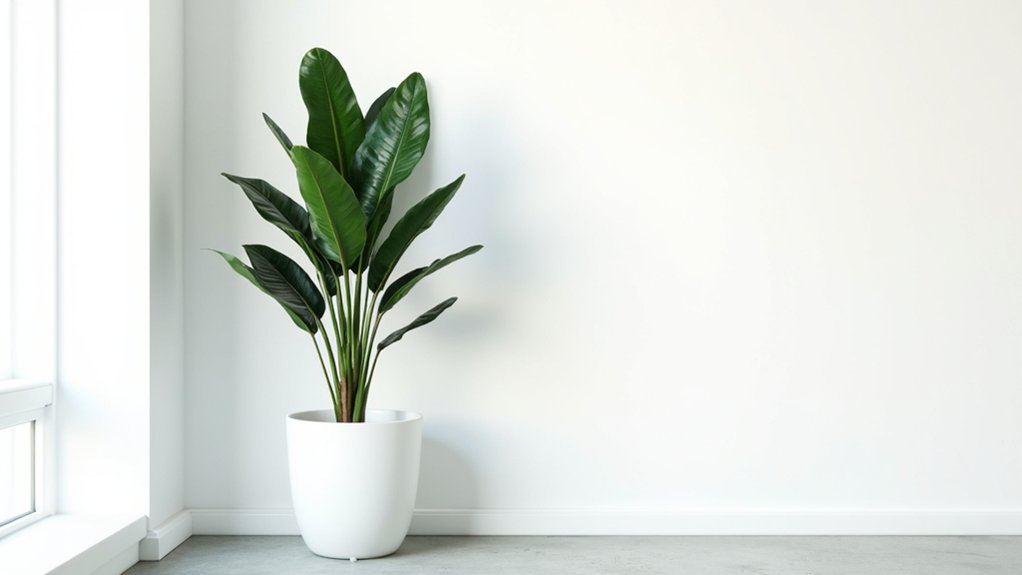
ZZ Plants (Zamioculcas zamiifolia) are perfect statement pieces for modern minimalist spaces, featuring glossy, dark green leaves arranged in a distinctive feather-like pattern along thick stems.
Their architectural form and clean lines complement contemporary interior design while adding a sophisticated touch of nature. The plants’ naturally symmetrical growth pattern and upright structure make them ideal for sleek containers or as standalone specimens in minimalist room corners.
- Light: Tolerates low to moderate indirect light; avoid direct sunlight
- Water: Allow soil to dry between waterings; water every 2-3 weeks
- Soil: Well-draining potting mix with added perlite
- Temperature: Thrives in 65-75°F (18-24°C)
- Humidity: Adapts to average indoor humidity levels
- Container: Pot with drainage holes; prefers to be slightly root-bound
Regular maintenance of ZZ Plants primarily involves dust removal from leaves using a soft, damp cloth to maintain their glossy appearance and ensure optimal photosynthesis.
Remove any yellowing leaves at the base, and rotate the plant quarterly to promote even growth. While these plants are slow-growing, they may need repotting every 2-3 years when roots become visible through drainage holes.
Inspect occasionally for rare pest issues, though ZZ Plants typically resist most common houseplant problems.
Hanging Spider Plants for Vertical Interest
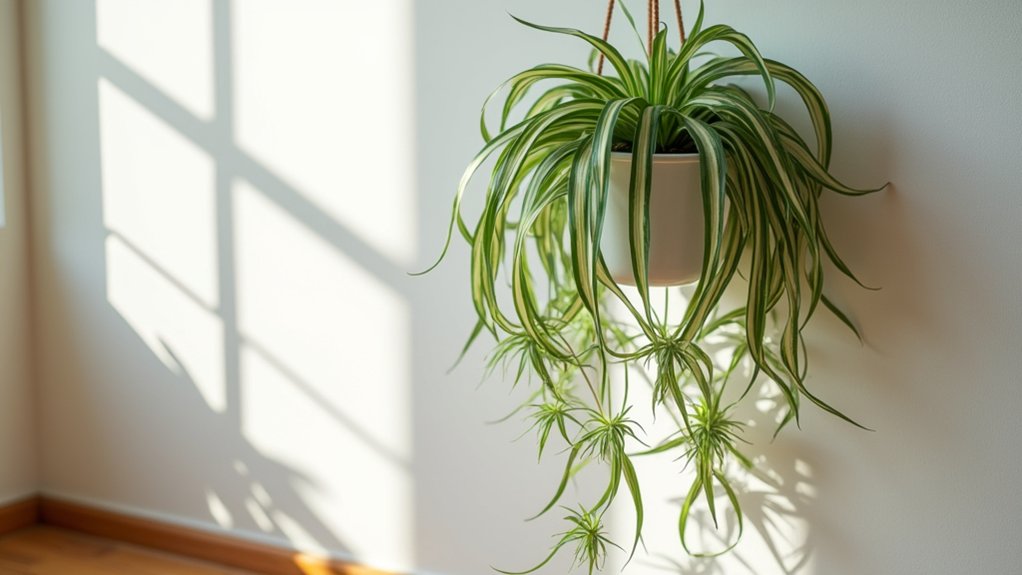
Spider plants (Chlorophytum comosum) suspended in hanging baskets create an elegant cascade of arching, grass-like foliage that adds dramatic vertical interest to any living room. Their distinctive appearance features long, slender leaves with variegated stripes, and they produce tiny plantlets, or “spiderettes,” that dangle from long stems, creating a striking waterfall effect.
This architectural display makes them particularly suited for placement near windows or in corners where their trailing nature can be fully appreciated.
- Light: Bright, indirect sunlight; can tolerate moderate shade
- Water: Keep soil moderately moist; allow top inch to dry between waterings
- Humidity: Tolerates average indoor humidity levels
- Temperature: 60-75°F (15-24°C)
- Soil: Well-draining potting mix
- Container: Hanging basket with drainage holes
- Fertilizer: Monthly feeding during growing season with balanced liquid fertilizer
Regular grooming is key to maintaining an attractive hanging spider plant. Remove any yellowed or brown leaves at their base, and trim off spent spiderettes unless you plan to propagate them.
Rotate the basket quarter-turn weekly to ensure even growth, and dust the leaves periodically with a damp cloth to maintain their photosynthetic efficiency. If the plant becomes root-bound or too large for its container, divide it or repot in spring using fresh potting mix to rejuvenate growth.
Peace Lily: The Air-Purifying Beauty
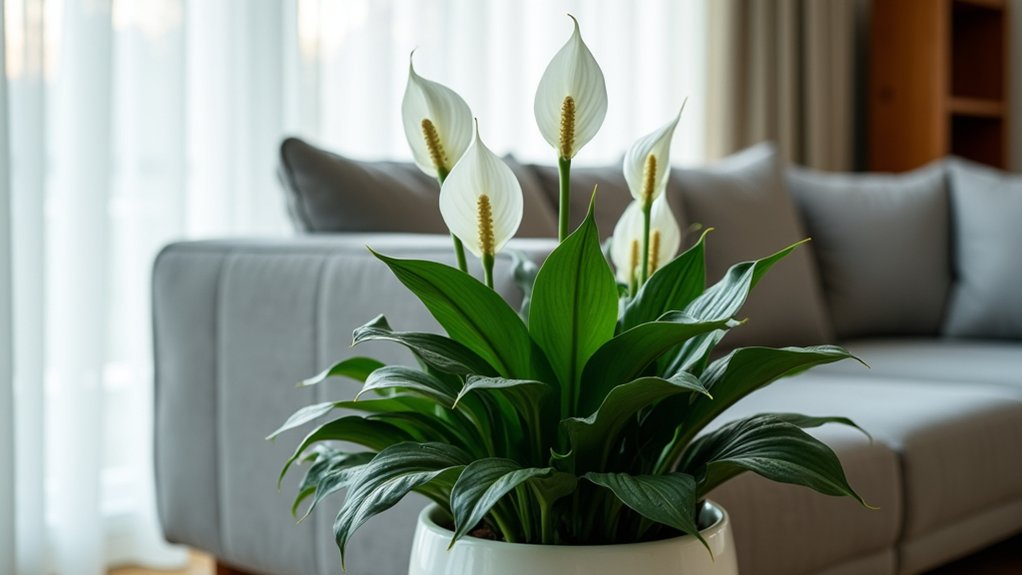
The Peace Lily (Spathiphyllum) is an elegant tropical plant known for its glossy, dark green leaves and distinctive white flowers that rise above the foliage like flags of surrender. This versatile houseplant not only adds sophisticated beauty to living spaces but also serves as a natural air purifier, effectively removing common indoor pollutants such as benzene, formaldehyde, and carbon monoxide from the air.
- Light: Thrives in medium to low indirect light; avoid direct sunlight
- Water: Keep soil consistently moist but not waterlogged; water when top inch of soil feels dry
- Soil: Well-draining potting mix rich in organic matter
- Temperature: 65-80°F (18-27°C)
- Humidity: Prefers high humidity levels; mist regularly or use a humidity tray
- Fertilizer: Feed with balanced liquid fertilizer every 6-8 weeks during growing season
To maintain a healthy Peace Lily, regularly dust the leaves with a damp cloth to keep their pores clear for optimal photosynthesis and air purification.
Remove yellowing leaves and spent flowers at their base to encourage new growth and maintain the plant’s appearance.
Watch for signs of common issues like brown leaf tips, which often indicate either over-fertilization or tap water sensitivity.
Consider using filtered water if your tap water contains high levels of fluoride or chlorine, and relocate the plant if you notice leaf scorching or poor flowering.
Statement Monstera for Natural Drama
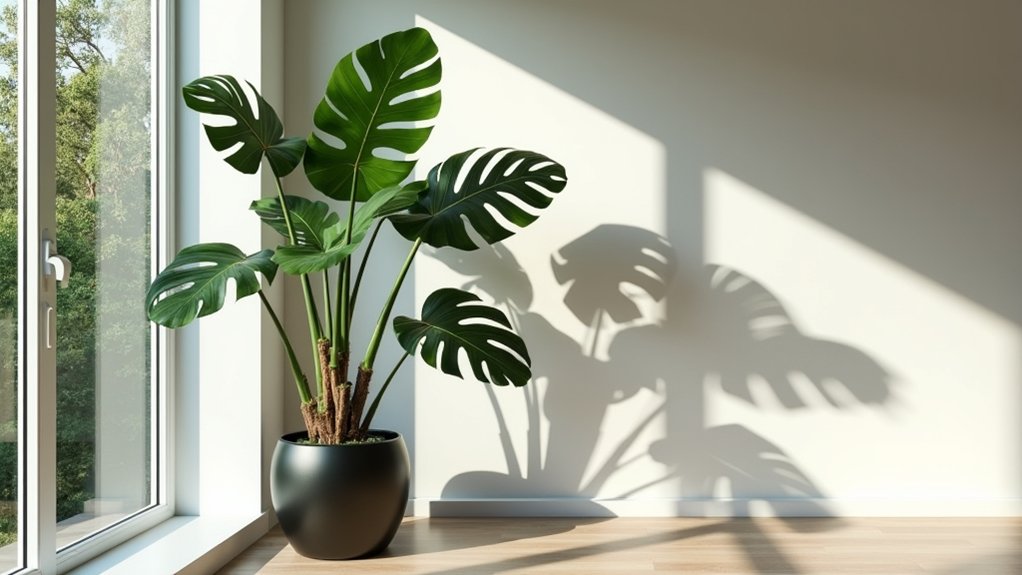
The Monstera deliciosa, commonly known as the Swiss cheese plant, creates an impressive focal point in any living room with its large, glossy, perforated leaves that can span up to three feet wide.
These dramatic tropical plants develop their characteristic splits and holes as they mature, creating a bold architectural statement that draws the eye upward as they climb or cascade from elevated positions. Their deep green foliage and unique leaf patterns make them an increasingly popular choice for adding natural drama to interior spaces.
- Light: Bright, indirect sunlight; can tolerate moderate shade but may develop fewer leaf holes
- Water: Allow top 2-3 inches of soil to dry between waterings
- Soil: Well-draining, rich potting mix
- Humidity: Prefers 60% or higher
- Temperature: 65-85°F (18-29°C)
- Container: Large pot with drainage holes
- Support: Moss pole or trellis for climbing
Regular grooming and positioning adjustments help maintain a statement Monstera’s striking appearance.
Dust leaves monthly with a damp cloth to maintain their glossy finish and ensure efficient photosynthesis. Rotate the plant quarterly to encourage even growth, and trim yellowing or damaged leaves at the base.
As the plant grows, guide new stems toward their support structure and consider pruning overly lengthy aerial roots. During the growing season, supplement with a balanced, water-soluble fertilizer every 4-6 weeks to promote healthy leaf development and maintain the plant’s dramatic presence.
Rubber Plants for Rich Color Contrast
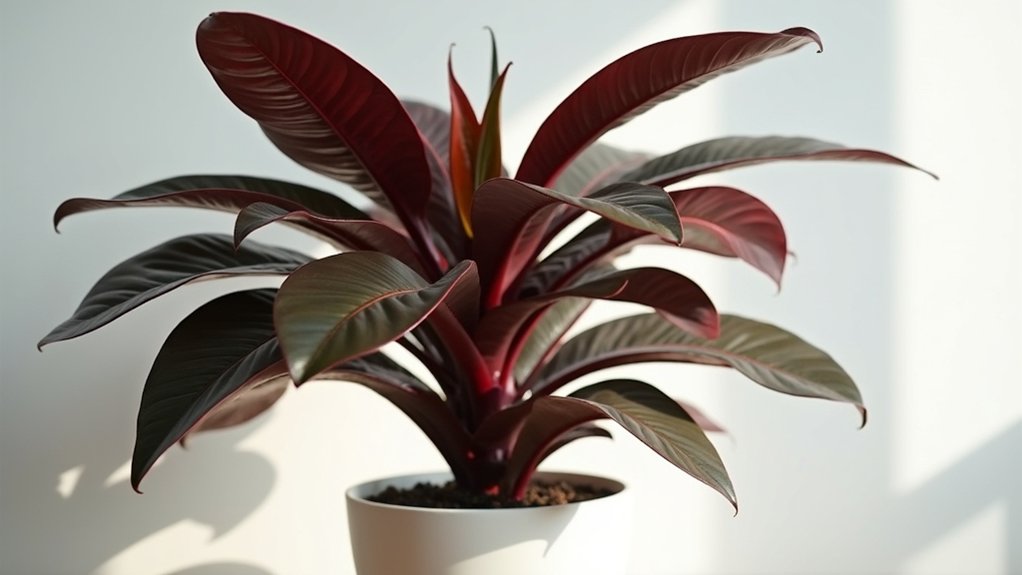
Rubber plants (Ficus elastica) bring dramatic visual impact to living rooms with their large, glossy leaves in deep green, burgundy, or variegated patterns.
These striking plants can grow quite tall indoors, featuring thick, leathery foliage that creates bold contrast against light-colored walls or furniture. The leaves emerge from a central stem in a distinctive burgundy sheath, unfurling to reveal their rich coloration and adding architectural interest to any space.
- Light: Bright, indirect sunlight; can tolerate moderate light but may lose lower leaves
- Water: Allow top 1-2 inches of soil to dry between waterings
- Soil: Well-draining potting mix rich in organic matter
- Humidity: Moderate to high; benefits from regular misting
- Temperature: 60-80°F (15-27°C)
- Fertilizer: Monthly feeding during growing season with balanced liquid fertilizer
- Container: Choose pot with adequate drainage holes
Regular dusting of leaves with a damp cloth maintains their glossy appearance and helps the plant photosynthesize effectively.
Prune any damaged or yellowing leaves at the base, and rotate the pot quarterly to encourage even growth. When the plant becomes too tall, cut back the main stem to promote bushier growth, and use clean, sharp pruning shears to prevent disease transmission.
Support larger specimens with a moss pole or sturdy stake to maintain upright growth.
Succulents for Window Ledge Charm
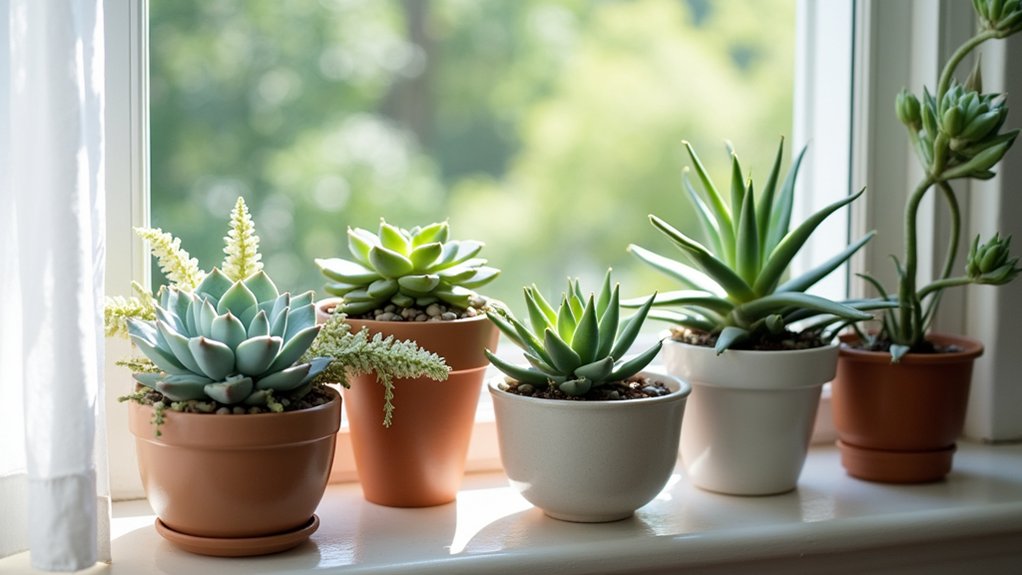
Succulents create an enchanting display when arranged along window ledges, offering a diverse collection of shapes, sizes, and colors that catch natural light beautifully.
These water-wise plants feature thick, fleshy leaves in rosette patterns, trailing forms, or upright growth habits, making them perfect for ledge arrangements where their architectural forms can be fully appreciated.
- Light: Bright, indirect sunlight with some direct morning sun; protect from harsh afternoon rays
- Water: Allow soil to dry completely between waterings; reduce watering in winter
- Soil: Well-draining cactus or succulent mix
- Temperature: 60-80°F (15-27°C)
- Humidity: Low to moderate; tolerates dry air well
- Container: Pots with drainage holes; shallow containers work well for most varieties
- Spacing: 2-3 inches between plants when grouping
Regular grooming and proper positioning are essential for window ledge succulents to thrive.
Remove any dead or yellowing leaves promptly to prevent rot, rotate containers quarterly for even growth, and inspect beneath leaves for pests like mealybugs.
During winter months, move plants slightly away from cold windows to protect from drafts, and consider using a layer of decorative gravel on soil surfaces to minimize water splashing and maintain cleaner ledges.
